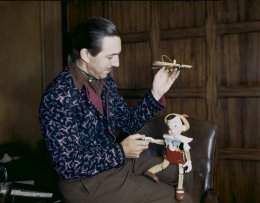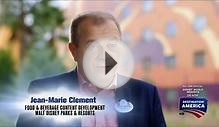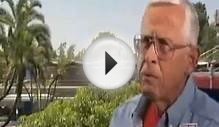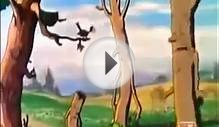
 1 of 3
1 of 3
Walt Disney with a marionette version of Pinocchio. COURTESY OF DISNEY/PBS
BY MICHAEL HEWITT / TELEVISION CRITIC
'American Experience: Walt Disney'
What: A two-part, four-hour biography of Walt Disney
When: 9 p.m. Monday-Tuesday
Channel: PBS
Nearly 50 years after his death, Walt Disney has been transformed from a man into a symbol. He’s the eponym of a giant corporation, a bronze statue greeting visitors to Disneyland, an avuncular figure who assures buyers of Disney products that family-friendly, emotionally uplifting pleasure lies ahead.
But he was, at one point, an actual human being. In an exhaustive but always lively four-hour, two-part biography on PBS’ “American Experience, ” director Sarah Colt attempts to reconstruct Disney the person.
And he was no ordinary person. Walter Elias Disney was one of those rare characters to whom the term “genius” can be applied with little argument.
Disney belonged to that class of Americans that includes the likes of Thomas Edison and Steve Jobs: those who possess not only a world-changing vision but the passion, ego and endless energy to realize that vision, even in the face of repeated failure.
And like Edison and Jobs, Disney also viewed the rest of the world as composed of people who were either helping him or getting in his way. If his workers asked for troubling items like a paycheck, Disney felt betrayed.
The “American Experience” film presents both sides of Disney candidly. No doubt some will find Walt treated too poorly, others too well, but the filmmakers do back up their point of view with copious detail and testimony from film historians, people who knew Disney and, occasionally, Walt himself.
The style is unabashedly lifted from Ken Burns: Historical still photos and film clips play behind the melodious narration of Oliver Platt, intercut with contemporary speakers. It may not be revolutionary, but it’s a format that works. Even at nearly four hours, “Walt Disney” moves briskly.
The documentary flows mostly in chronological order, following Walt’s life from his youth in the Midwest to his budding animation career in Kansas City and out to California and sensational fame and success.
The picture of Disney is built largely from the outside in. There is little attempt to analyze his personality beyond the telling and almost heartbreaking fact that his father, Elias Disney, was a man with little tolerance for levity or play in his children. It is easy to infer that Walt’s career was an attempt to build a childhood he never had, but the filmmakers don’t dwell on the point.
Instead they move on quickly to Walt’s career, and mostly stay there. And what an incredible career it was: The first sound cartoons, the first feature-length animated film, the invention of nature documentaries, a record number of Oscars, a seemingly endless list of popular characters. And of course, Disneyland and Disney World, Walt’s reinvention of the amusement park.
Through it all, the man who emerges is a true giant, in both vision and ego. Walt Disney was a notoriously hard worker who barely slept and was always on the move, chain-smoking all the while, slowing down only for the occasional glass of scotch over crushed ice.
He also hated sharing credit, kept tight control over decision-making and ran into repeated problems with his employees, for whom he seemed to have little regard.
The story of Walt Disney is also the story of his brother Roy, his loyal partner and the cooler, more practical side of the business. Roy stuck by his brother, even after Walt unilaterally changed the name of the company from Disney Brothers Studios to Walt Disney Studios.
And Roy was often the man who solved Walt’s problems. He was the one who figured out how to pay for sound equipment the company could ill afford to make “Steamboat Willie.” And Roy was the one who solved the seemingly intractable labor problems that Walt created in the 1930s.
RELATED VIDEO











